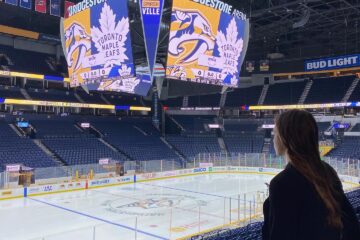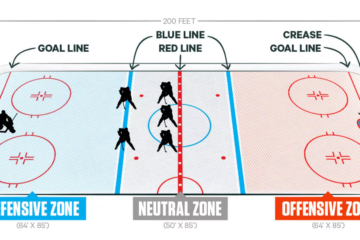I wanted to take some time to answer some hockey questions I had from my readers. I’ll talk about a couple of calls: offside and icing. I will also go into why teams pull their goalies and what the home-ice advantage looks like in the playoffs.
Offsides Call
Offsides happen when an attacking player has crossed the blue line before the puck has fully crossed. Lots of times you’ll see guys stretch their legs out as much as they can if they get to the attacking zone before the guy with the puck.
Blue Line
The ice is divided into three different zones: the defensive, neutral, and offensive zones. Those three zones are separated by two blue lines. The purpose of the blue line is to stop players from entering the offensive zone before the puck has crossed. Without the blue line/offsides rule, it would be too easy for the attacking team to get behind the defending team.
It is okay if a player’s stick, head, body, or one skate has gone across as long as the puck beats both skates over the line.
Play Called Offside
Once the linesman, who is the official tasked with determining if a play is offside or not, calls the play offside, the play then becomes dead. After the play is called dead, the faceoff will be placed at one of the two faceoff dots closest to that blue line in the neutral zone.
Delayed Offsides
From the fan’s perspective, sometimes the fewer whistles the better. The game tends to flow better and go faster without as many stoppages.
So, if a puck crossed the blue line that could be called offside but if someone touches up the puck on the defensive team and brings the puck out of the zone, the linesman will raise his arm to signal a delayed offside.
When this happens, the players on the attacking team that were called offside are given a chance to “tag up” or exit the offensive zone before they could re-enter or touch the puck again. All of the players on the attacking team must tag up before they could re-enter the zone.
Offside Challenge
After a goal is scored, the opposing team has the opportunity to challenge if they believe the play that led to the goal was offside but wasn’t called. If a team decides to challenge, the refs as well as the situation room in Toronto take a look at the play. If the challenge was successful, the goal comes back. But if a challenge is unsuccessful, then the challenging team receives a 2-minute delay of game penalty.
Icing Call
One of the most confusing calls, but a very common call, icing. This is a call that once you know it, it’s easy to understand but to explain it is a bit hard.
So, on top of the two blue lines, there’s a center red line that divides the rink in half. Then there are the two thinner red lines by the goals which are the goal lines. Icing takes place when any player shoots the puck from anywhere on his side of the center red line down past the goal line of the opposing side. This calls for an automatic stoppage with a faceoff in the zone of the team that “iced” the puck.
There are a couple of exceptions to the rule. If the puck is shot before the red line but doesn’t make it to the goal line on the opposite side, there is no icing. This could be if it deflects off the boards, a player, or a stick. The other is at the lineman’s discretion, but if he believes the opposing team has the ability to play the puck before it gets to the goal line, the icing is waived.
No Line Change
This rule started back in the 1930s because players would shoot the puck from one side to the other to waste time, especially at the end of the game. After introducing the rule, players would still continue this to allow for line changes. Therefore, in the early 2000s, the team that iced the puck was not allowed to make a line change after the icing was called, only the opposing team could have a line change. If a player hops onto the bench as the puck is being iced, the player has to come back onto the ice for the faceoff.
Icing on the Penalty Kill
The only time a player is allowed to ice the puck without icing being called is during the penalty kill. When a team is short a player, due to a penalty, the team has the chance to ice the puck as much as they can. This wastes time but also slows the other team down by having to chase the puck.
Pulling the Goalie
A common strategy when a team is down by a goal or two is to pull the goalie and put in an extra attacker. This typically happens in the last two to three minutes if down by one, but I have seen coaches pull their goalie with five or more minutes left if they’re down by two.
This is a risky move. While it does give the losing team a better offensive advantage, it also gives the winning team a chance to score an empty net, making the lead larger. The goalie is allowed to go back into the net after being pulled.
Primary Reason
While others may think it’s crazy to pull the goalie (me being one), there is a valid reason for pulling them. Although it’s not the most common for the team to score, sometimes they do tie up the game. Gaining that additional point by going into overtime could make all the difference when it comes to a team making it into the playoffs or not. If a team were to lose in regulation, they don’t receive any points, but if they lose in overtime, they at least receive one.
I was asked, why doesn’t the goalie just chill on the bench after an empty net goal instead of going back in? It would make sense to let the guy just chill on the bench, but goal differential could come into play due to the tie-breaking procedures, so it’s best not to have any more empty net goals. So, when it comes to the final standings it could come down to the team with the greater differential between goals for and against, marked as DIFF, being in the higher place.
Home-Ice Advantage
In my post about the Presidents’ Trophy, I mention the Presidents’ Trophy winner is guaranteed home-ice advantage throughout their playoff run. But what about the other teams? Home-ice advantage during the first two rounds goes to the team with that placed higher in the regular season. And for the Conference Final (round 3) and Stanley Cup Final (round 4), home-ice advantage goes to the team that had the better regular season record regardless of their standing in their divisions. Each round is played in a 2-2-1-1-1 format, meaning the top team hosts games one and two, then five, and seven if needed and the opponent hosts games three and four then six if needed.
If you have any further questions, be sure to submit a Fan Question form! And don’t forget to subscribe to my email!



